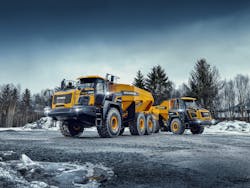Hyundai Construction Equipment Americas Enters Articulated Dump Truck Market
Hyundai Construction Equipment Americas is entering the articulated dump truck market with two new models – the HA30 and HA45 articulated dump trucks – targeting the 30- and 45-ton segments. The first of the new ADTs are now available for order through Hyundai’s North American network of authorized dealers.
With rated payloads of 28 and 41 tons respectively, the HA30 and HA45 articulated dump trucks provide a haul truck match for Hyundai’s larger crawler excavators and wheel loaders. Designed primarily for high-volume earthmoving projects, highway construction, and mine and quarry operations, Hyundai’s articulated haulers provide drive and traction.
“Hyundai is excited to enter the ADT market to better serve our customers in aggregates and infrastructure construction,” said Mike Ross, senior vice president of CE sales, parts & service, Hyundai Construction Equipment Americas. “Our new ADT models are the first collaborative results of the combined design, engineering, and manufacturing expertise of Hyundai Construction Equipment and Hyundai Doosan Infracore.”
In 2021, Hyundai Heavy Industries Group purchased the Doosan business, which now operates – along with Hyundai Construction Equipment – as a separate division within Hyundai Genuine. While maintaining their respective management and dealer network structures, the two divisions plan further integration in R&D, design, engineering, procurement, and manufacturing.
Articulated Hauling
The new Hyundai HA30 and HA45 trucks are built around a full-time six-wheel-drive concept, with front and rear limited-slip differentials and a longitudinal differential that can be manually locked, for maximum drive and traction on difficult terrain.
The trucks have a compact chassis design, to aid maneuverability, with a sloping rear frame and a front-mounted differential integrated into the ZF transmission, allowing for a shorter front frame section. This results in the smallest turning radius in the vehicle class and stability. Self-leveling hydro-gas suspension on the front axle further supports a comfortable ride.
The turning ring is mounted in front of the chassis articulation point, resulting in equal weight distribution to the front wheels in all driving situations.
Tandem reduction gearboxes on the two rear axles enable maximum oscillation of the rear axles to maintain ground contact on rough terrain. The single central differential increases ground clearance beneath the truck. Oil-cooled wet disc brakes achieve an extended service life of up to 15,000 hours. A hydraulically activated mechanical parking brake holds the machine when stationary. The trucks are supplied with a gradient meter, with flip-over protection and a body over center of gravity function, to assist drivers when dumping and operating on rough terrain.
The HA30 has a 22 yard (16.8 m3) heaped body capacity, that rises to 23.3 yards (17.8 m3) when fitted with a tailgate. The larger HA45 offers a 32 yard (24.4 m3) heaped capacity, rising to 34 yards (26 m3) with a tailgate. Both dump bodies can be optionally heated by the engine exhaust gases to prevent freezing and sticking of materials when operating in colder temperatures. Internal wear plates are available as an option when working in applications with heavy and hard rock.
Proven Powertrain
Tier 4 Final Scania diesel engines power both trucks. The HA30 uses a five-cylinder, 9.3-liter DC9 turbocharged diesel, producing 375 hp (276 kW) and 1,876 Nm of torque. The larger HA45 uses a six-cylinder, 12.7-liter DC13 diesel engine, producing a maximum of 500 hp (368 kW) and 2,476 Nm of torque.
Both engines drive through eight-speed ZF automatic transmissions. The torque converter has lock-up in all gears, reducing fuel consumption and increasing efficiency. Ground-level service points are designed for maximum efficiency and improved safety. The engine canopy tilts forward for access to filters and fill points, while the complete cab structure can also be tilted towards the rear of the truck, to provide access for repair and maintenance.
Hyundai’s Hi-Mate telematic monitoring system is standard, with satellite and GSM connectivity, to reach inaccessible construction and mining sites. This enables remote monitoring of productivity, fuel consumption, system warning, and maintenance status, reducing unplanned downtime and improving fleet utilization.
